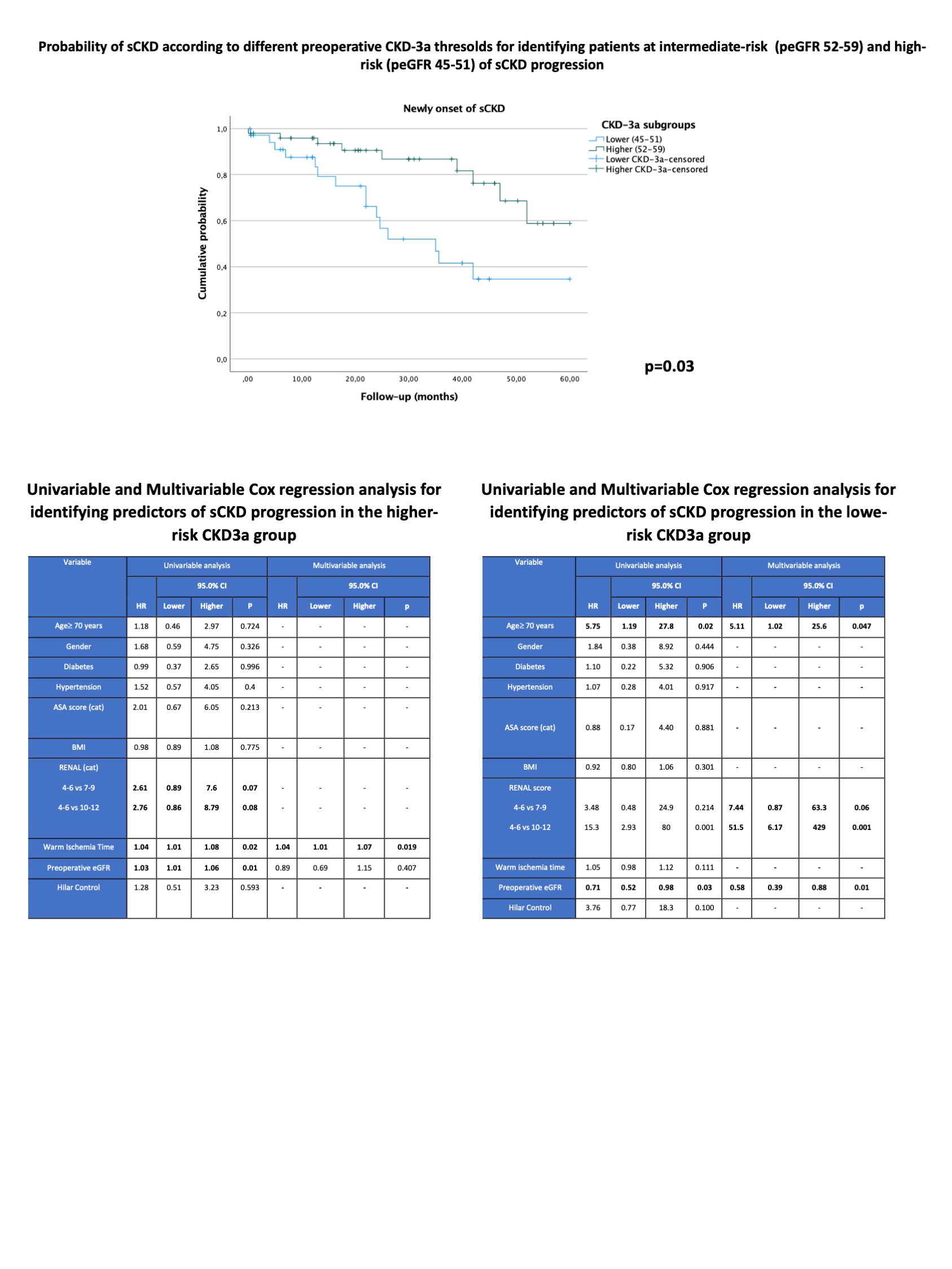Back
Poster, Podium & Video Sessions
Moderated Poster
MP24: Kidney Cancer: Localized: Surgical Therapy I
MP24-20: Analysis of predictors of sCKD progression after minimally-invasive imperative partial nephrectomy in patients with preoperative CKD stage 3a: results of a multi-institutional collaborative series
Saturday, May 14, 2022
8:45 AM – 10:00 AM
Location: Room 222
Umberto Anceschi*, Rome, Italy, Andrea Minervini, Andrea Mari, Antonio Andrea Grosso, Florence , Italy, Cristian Fiori, Francesco Porpiglia, Orbassano, Turin, Italy, Gabriele Tuderti, Alfredo Maria Bove, Aldo Brassetti, Leonardo Misuraca, Riccardo Mastroianni, Mariaconsiglia Ferriero, Rome, Italy, Daniele Amparore, Orbassano , Italy, Riccardo Autorino, Richmond, VA, Alessandro Veccia, Brescia , Italy, Chandru Sundaram, Indianapolis , IN, Daniel Eun, Philadelphia, IN, Jennifer Lee, Philadelphia, PA, Ithaar Derweesh, San Diego , CA, Umberto Capitanio, Alessandro Larcher, Francesco Montorsi, Milan , Italy, Michele Gallucci, Giuseppe Simone, Rome, Italy

Umberto Anceschi
IRCCS "Regina Elena" National Cancer Institute
Poster Presenter(s)
Introduction: To analyze the progression to severe chronic kidney disease (stages =3b) in patients with preoperative CKD stage 3a who underwent minimally-invasive partial nephrectomy (MIPN) for a solitary kidney or bilateral renal masses and to identify predictors of severe renal worsening in this cohort of patients.
Methods: A collaborative minimally-invasive partial nephrectomy dataset was restricted to “preoperative CKD3a stage” (n=215). Kaplan-Meier method was used to estimate the risk of progression to sCKD for the selected cohort according to different preoperative eGFR (peGFR) thresholds (range 45-51;=52). Patients with peGFR=52 ml/sec were identified at “lower risk” of sCKD (group A; n=126) while patients with 45=peGFR=51 were considered at “higher risk” of sCKD (group B; n=89). Cox regression analyses were performed to identify predictors of sCKD in both groups. For all analyses, a two-sided p < 0.05 was considered significant.
Results: Patients with higher preoperative CKD-3a thresholds displayed a decreased progression to sCKD compared to lower preoperative CKD-3a thresholds (p=0.03) High-risk patients showed significantly higher ASA score and clinical tumor size compared to lower risk group (each p<0.03). With regard to perioperative outcomes, high-risk patients had increased ?eGFR at discharge (p < 0.05). At a median follow-up of 20 months (IQR 9-44), in the B group patients showed higher CKD stages and sCKD, respectively (each p<0.02). On multivariable analysis, in the lower risk group age=70 years (HR 5.1; 95% CI 1.02-25.6; p=0.04), RENAL score (HR 51.5; 95% CI 6.17-429; p=0.001) and peGFR (HR 0.58; 95% CI 0.39-0.88; p=0.01) were all independent predictors of sCKD. In the high-risk group, warm ischemia time (HR 1.04; 95% CI 1.01-1.07; p=0.019) was the only independent predictors of sCKD.
Conclusions: In the setting of moderate preoperative renal impairment, we suggested novel peGFR ranges to identify patients at different risk of sCKD. For patients with higher CKD3a thresholds, tumor complexity and age=70 years are independent predictors of renal function worsening while for patient with lower peGFR, warm ischemia time remains the only modifiable factor to avoid a quicker onset of sCKD.
Source of Funding: No

Methods: A collaborative minimally-invasive partial nephrectomy dataset was restricted to “preoperative CKD3a stage” (n=215). Kaplan-Meier method was used to estimate the risk of progression to sCKD for the selected cohort according to different preoperative eGFR (peGFR) thresholds (range 45-51;=52). Patients with peGFR=52 ml/sec were identified at “lower risk” of sCKD (group A; n=126) while patients with 45=peGFR=51 were considered at “higher risk” of sCKD (group B; n=89). Cox regression analyses were performed to identify predictors of sCKD in both groups. For all analyses, a two-sided p < 0.05 was considered significant.
Results: Patients with higher preoperative CKD-3a thresholds displayed a decreased progression to sCKD compared to lower preoperative CKD-3a thresholds (p=0.03) High-risk patients showed significantly higher ASA score and clinical tumor size compared to lower risk group (each p<0.03). With regard to perioperative outcomes, high-risk patients had increased ?eGFR at discharge (p < 0.05). At a median follow-up of 20 months (IQR 9-44), in the B group patients showed higher CKD stages and sCKD, respectively (each p<0.02). On multivariable analysis, in the lower risk group age=70 years (HR 5.1; 95% CI 1.02-25.6; p=0.04), RENAL score (HR 51.5; 95% CI 6.17-429; p=0.001) and peGFR (HR 0.58; 95% CI 0.39-0.88; p=0.01) were all independent predictors of sCKD. In the high-risk group, warm ischemia time (HR 1.04; 95% CI 1.01-1.07; p=0.019) was the only independent predictors of sCKD.
Conclusions: In the setting of moderate preoperative renal impairment, we suggested novel peGFR ranges to identify patients at different risk of sCKD. For patients with higher CKD3a thresholds, tumor complexity and age=70 years are independent predictors of renal function worsening while for patient with lower peGFR, warm ischemia time remains the only modifiable factor to avoid a quicker onset of sCKD.
Source of Funding: No


.jpg)
.jpg)